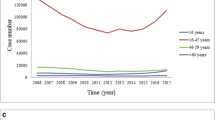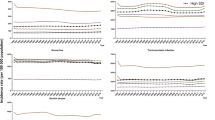Abstract
Recent reports of increased rates of gonorrhea initiated an analysis of secular trends of gonorrhea in a young adult population. Gonorrhea is a notifiable disease in the Israel Defense Forces. The diagnosis is based on the typical clinical presentation, relevant epidemiologic data, and positive bacteriological culture. For the present study, the archives of the Epidemiology Department were reviewed for all documented cases of gonorrhea from January 1, 1978 to December 31, 2008, and the annual and seasonal incidence rates were calculated. Annual gonorrhea rates decreased from 2.3 cases per 1,000 soldiers in 1978 to an all-time low of 0.07 cases per 1,000 soldiers in 2008, representing a 97% decline. Multi-year average monthly rates varied from a low of 5.83 cases per 100,000 population in February to a high of 8.97 cases per 100,000 in August. The difference in the person-time incidence (PTI) rates for winter (5.9 cases per 100,000 person-years) and summer (6.8 cases per 100,000 person-years) was statistically significant (p < 0.01). Analyzing the long-term epidemiology of gonorrhea has shown that the infection rate is continuously decreasing and that it appears to be more prevalent in the warmer months.


Similar content being viewed by others
References
Centers for Disease Control and Prevention (CDC) (2009) Sexually transmitted diseases surveillance, 2008. Available online at: http://www.cdc.gov/std/stats08/gonorrhea.htm
Green MS, Anis E, Gandacu D, Grotto I (2003) The fall and rise of gonorrhoea incidence in Israel: an international phenomenon? Sex Transm Infect 79:116–118
Gellan MCA, Ison CA (1986) Declining incidence of gonorrhoea in London: a response to fear of AIDS? Lancet 2:920
Carne CA, Weller IVD, Johnson AM, Loveday C, Pearce F, Hawkins A, Smith A, Williams P, Tedder RS, Adler MW (1987) Prevalence of antibodies to human immunodeficiency virus, gonorrhoea rates, and changed sexual behaviour in homosexual men in London. Lancet 1:656–658
Ministry of Health, State of Israel (2006) Notifiable infectious diseases in Israel: 54 years of surveillance, 1951–2004. Available online at: http://www.health.gov.il/Download/pages/zihum2004_161209.pdf
Centers for Disease Control and Prevention (CDC) (2009) Sexually transmitted diseases surveillance, 2008, Table 1.Available online at: http://www.cdc.gov/std/stats08/tables/1.htm
Berglund T, Unemo M, Olcén P, Giesecke J, Fredlund H (2002) One year of Neisseria gonorrhoeae isolates in Sweden: the prevalence study of antibiotic susceptibility shows relation to the geographic area of exposure. Int J STD AIDS 13:109–114
Ehret JM, Judson FN (1998) Quinolone-resistant Neisseria gonorrhoeae: the beginning of the end? Report of quinolone-resistant isolates and surveillance in the southwestern United States, 1989 to 1997. Sex Transm Dis 25:522–526
Yagupsky P, Schahar A, Peled N, Porat N, Trefler R, Dan M, Keness Y, Block C (2002) Increasing incidence of gonorrhea in Israel associated with countrywide dissemination of a ciprofloxacin-resistant strain. Eur J Clin Microbiol Infect Dis 21:368–372
Schroeder B, Tetlow P, Sanfilippo JS, Hertweck SP (2001) Is there a seasonal variation in gonorrhea and chlamydia in adolescents? J Pediatr Adolesc Gynecol 14:25–27
Albus C, Köhler G (1988) Is there a seasonal incidence of acute adnexitis? Zentralbl Gynakol 110:824–826
Damiba AE, Vermund SH, Kelley KF (1990) Rising trend of reported gonorrhoea and urethritis incidence in Burkina Faso from 1978 to 1983. Trans R Soc Trop Med Hyg 84:132–135
Ross JD, Scott GR (1992) Seasonal variation in gonorrhoea. Eur J Epidem 8:252–255
Wright RA, Judson FN (1978) Relative and seasonal incidences of the sexually transmitted diseases. A two-year statistical review. Br J Vener Dis 54:433–440
Reinberg A, Lagoguey M (1978) Circadian and circannual rhythms in sexual activity and plasma hormones (FSH, LH, testosterone) of five human males. Arch Sex Behav 7:13–30
Seña AC, Miller WC, Hoffman IF, Chakraborty H, Cohen MS, Jenkins P, McKee KT Jr (2000) Trends of gonorrhea and chlamydial infection during 1985–1996 among active-duty soldiers at a United States Army installation. Clin Infect Dis 30:742–748
Author information
Authors and Affiliations
Corresponding author
Rights and permissions
About this article
Cite this article
Mimouni, D., Bar-Zeev, Y., Davidovitch, N. et al. Secular trends of gonorrhea in young adults in Israel: three decades of follow-up. Eur J Clin Microbiol Infect Dis 29, 1111–1115 (2010). https://doi.org/10.1007/s10096-010-0969-0
Received:
Accepted:
Published:
Issue Date:
DOI: https://doi.org/10.1007/s10096-010-0969-0




